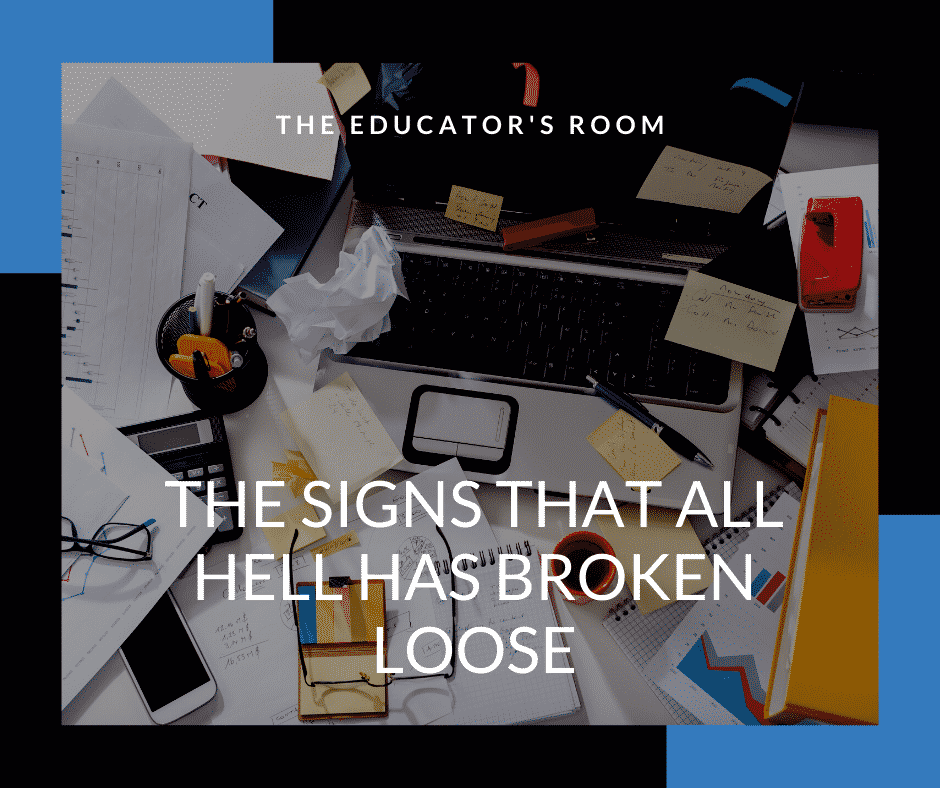Guest Writer: Jill Jackson
One of the things I have noticed as I’ve worked with teachers is the chaos.
The chaos of professional development (either too much training with no time to actually try anything or so little training teachers are searching social media in desperation to write their own curriculum each night).
The chaos of over-complicating things that don’t have to be that difficult (Did you know that teachers are spending years in professional development to learn how to collaborate with each other? Not collaborating…but learning to collaborate?)
The chaos of too many programs and resources (I surveyed the folks that I talk with every week and did you know that they are using more than forty-five different programs…and still, every single district and school has huge numbers of below benchmark students? Clearly more resources does not equal benchmark students!)
I could list a zillion other chaos points, but you get the idea.
The interesting thing is, this chaotic teaching lifestyle has become the norm. Teachers know it’s crazy and exhausting but it’s like teachers are resigned to this being how it is. And funny thing…teachers leaving the profession and a major teaching shortage has become the new normal, too. Go figure. We’re turning and burning our best and brightest either to leave the field of education or ever enter it, to begin with. Any of the ones that stay have almost been beaten into submission: just implement the program and we won’t have any problems.
Teaching doesn’t work like that.
It’s like gradually turning up the heat on a frog in a pot: we don’t really even know how we got here because it slowly has become our normal.
But in order to change things and restore our faith in how crucial excellent instruction is, we have to identify that we are out of control. They say the first step is admitting there’s a problem.
So here we go.
Here are the six signs that things are out of control. I encourage you to use them to assess your own professional life as an educator, but to also think about your school, district and state to see what rings true.
You are afraid to slow down.
Intuitively you know that keeping up the pace of implementing new things, remembering old things and trying to get a system going to manage it all, just isn’t going to work at this pace. However, it feels like if you call a time-out to just take stock in what the heck is going on, the whole thing will fall apart. Better yet, the message from leadership is “go, go, go” and “more, more, more” and “shiny penny, shiny penny, shiny penny…” and that just breeds an out of control-ness that makes us feel like professional implementers, not teachers.
We regularly see curriculum maps and standards-based (used loosely, I must add) programs that literally exceed the instructional minutes in a day and teachers are still required to implement the program with fidelity even though they don’t have enough time to fit it in. The math of what needs to be implemented and how much time it takes literally does not work! And folks know this before they start…and yet they feel like they can’t stop.
A really logical place to look for help with slowing down (though totally unhelpful) is time management. We have teachers who are thinking, “If only I could get organized and get a handle in my fancy lesson planner and build some pretty little organizational tools for myself and my students, I could figure this all out.” The real deal here? There is no figuring it out. Content has to be cut out in order for the most important stuff to have room to take root in your students. Just implementing programs doesn’t get kids to benchmark…thoughtful, careful teaching with lots of time for practice does.
You’re hoarding materials at a record pace.
I was recently working with a school that had fourteen (yes, 14) interventions they were using. When I asked them how it was working for them, they said, “We are really meeting all of the kids’ needs.” But when I looked at the scores for the school, I realized one thing for sure: they were NOT meeting the kids’ needs.
But as I dug deeper, I realized this one thing: they adopted and adopted and adopted new materials because they were trying to cover for a lack of teaching skill and structure. To them, if there was a student need, you plug it with a program. The problem? If the program was taught by a teacher who lacked classroom management or engagement, it was unlikely that the program would have any impact on students. And so onto the next program, the student would go.
[bctt tweet=”Schools are routinely assessing their success with students by how many resources they have for them. ” username=””]
Schools are routinely assessing their success with students by how many resources they have for them. And the problem? KIDS ARE CONFUSED. And so are teachers.
And, don’t get me started on how many teachers are forced to go down the rabbit hole of Teachers Pay Teachers and Pinterest to find the activity for the next day. The materials aren’t vetted, they are often only activities (instead of actual skill teaching) and they become a drug for the teacher rather than a tool to get students to benchmark.
The bottom line with materials? If you have simple materials taught by expert teachers, you’re golden.
Your activity is increasing but your productivity is decreasing.
The #1 complaint/frustration with teachers is a lack of time to do what they need to do. I mean it is no wonder, considering most teachers have 8+ programs they are trying to juggle to just get the students to master the grade-level content!
Teachers are breaking their backs trying to be more and more clever to catch and keep the students’ attention, they are changing things daily and weekly trying to keep things interesting and they are falling into the trap that somehow the fundamentals of teaching and learning aren’t working any longer.
Newsflash: When you aren’t getting the return on the investment of the teaching, prepping and collaboration with colleagues, something is off. And typically we are trying to do much. In order to be successful in the classroom, teachers must have the ability to choose which great idea/lesson/activity needs to be left behind. You cannot do it all.
We’re trying to do it all and the scores nationwide are lower than ever. Something’s got to give.
The line between personal time and work time is blurred
There is not much to say about this one except for this: I do believe that teachers will have to bring work home. And I don’t believe this the crime of the century. We are professionals with professional responsibilities that don’t stop when the bell rings at the end of the day.
However, when the ability to do the work that directly relates to giving students feedback in compromised, then we are way off track. Having to bring work home is secondary to the fact that the students are delayed in getting feedback from their teacher. For example, if I took a test on Tuesday and my teacher was overwhelmed with other ridiculous tasks put on teachers during the week that she couldn’t grade my test until the weekend, it could be nearly a week before I received feedback. That’s just too late…we’ve more than moved on by then.
So the issue of taking work home is not just that teachers who have a satisfying personal life are more powerful teachers (it’s true), but that it gets in the way of students getting to grade-level benchmark.
And let’s be honest, when a teacher shows up on Monday after a long weekend of working on school stuff, the exhaustion, resentment and frustration shows…just ask the kids.
You underreact to important things and overact to almost everything else.
To be really honest, I am freaking out at the recent NAEP scores. And you should be too.
The scores show that we are doing a rather horrific job at getting our students to benchmark in reading and math in almost every state in the country. I mean, under what circumstances have we grown so calloused to the idea that a student could attend virtually every day of school for 13 years and not know the basics of reading and math at the end of it all?
An interesting development in underreacting to the things that matter is how we are starting to overreact to things that are truly secondary to students hitting the benchmark. We are idolizing soft skills like “student agency” (gag me), “student choice” (huh?) and “equity” (what does it all mean?) and making those secondary things the main things. More to come on these distractions.
Nothing’s fun anymore.
We work with kids. Kids are inherently funny…whether they know they’re being funny or not. If their idiosyncrasies and weirdness don’t delight us anymore, that diminishes the power of the teaching. Our students know that we’re not having fun…and, in turn, they don’t have much fun. They are the ultimate litmus test in matching our level of frustration, overwhelm and dissatisfaction. It’s uncanny.
I used to love lesson planning because it was such a creative process and felt really good to have a cohesive plan for teaching the next week. But since we’re over-programmed, over-trained and not given a moment to get better at the fundamentals and the advanced techniques in teaching, things that we used to love (lesson planning, finding new ideas, collaborating with our teammates) become a burden.
Do any of these signs that you’re out of control sound familiar?
We’ve got to fix this. And it’s not going to be fixed by the “powers that be,” but by you. From the inside out.




